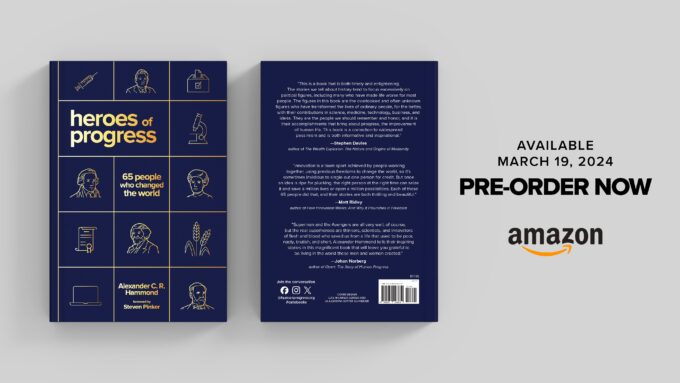Summary: Many young people today are pessimistic about the future of the planet and humanity, believing that environmental degradation, poverty, violence, and inequality are getting worse. However, this gloomy outlook is not supported by the facts, which show remarkable improvements in living standards, health, education, peace, and prosperity over the last century. This article explores why people are so prone to pessimism and how to overcome it by examining the evidence of human progress.
Do you believe that the world is coming to an end? If so, you are not alone.
In 2021, researchers at the University of Bath polled 10,000 young people between the ages of 16 and 25 in Australia, Brazil, Finland, France, Great Britain, India, Nigeria, the Philippines, Portugal, and the United States. The researchers found that, on average, 83 percent of respondents thought that “people have failed to care for the planet.” Seventy-five percent thought that the “future is frightening.” Fifty-six percent thought that “humanity is doomed.” Fifty-five percent thought that they will have “less opportunity than [their] parents.” Finally, 39 percent stated that they were “hesitant to have children.”
The study remains one of the most comprehensive surveys of young people’s perception of the environmental state of the planet. But is this kind of doom warranted? The following global statistics paint an entirely different picture:
Between 1950 and 2020, the average inflation-adjusted income per person rose from $4,158 to $16,904, or 307 percent. Between 1960 and 2019, the average life expectancy, rose from 50.9 years to 72.9 years, or 43.2 percent. (Unfortunately, the pandemic reduced that number to 72.2 years.)
Between 2000 and 2020, the homicide rate fell from 6.85 per 100,000 to 5.77, or 16 percent.
Deaths from inter-state wars fell from a high of 596,000 in 1950 to a low of 49,000 in 2020, or 92 percent (though the war between Russia and Ukraine is bound to increase that number).
The rates of extreme poverty have plummeted, with the share of people living on less than $1.90 per day declining from 36 percent in 1990 to 8.7 percent in 2019. Though, once again, the pandemic has temporarily worsened that number somewhat.
Between 1969 and 2019, the average infant mortality rate per 1,000 live births fell from 89.7 to 20.9, or 77 percent.
Between 1961 and 2018, the daily supply of calories rose from 2,192 to 2,928, or 34 percent. Today, even in Africa, obesity is a growing concern.
The gross primary school enrollment rate rose from 89 percent in 1970 to 100 percent in 2018. The gross secondary school enrollment rate rose from 40 percent to 76 percent over the same period. Finally, the gross tertiary school enrollment rate rose from 9.7 percent to 38 percent.
The literacy rate among men aged 15 and older rose from 74 percent in 1975 to 90 percent in 2018. The literacy rate among women aged 15 and older rose from 56 percent in 1976 to 83 percent in 2018.
In 2018, 90 percent of women between the ages of 15 and 24 were literate. That number was almost 93 percent among men of the same age. The age-old literacy gap between the sexes has all but disappeared.
There is plenty of good news on the global environmental front as well:
The chance of a person dying in a natural catastrophe — earthquake, flood, drought, storm, wildfire, landslide or epidemic — fell by almost 99 percent over the last century.
Between 1982 and 2016, the global tree canopy cover increased by an area larger than Alaska and Montana combined.
In 2017, the World Database on Protected Areas reported that 15 percent of the planet’s land surface was covered by protected areas. That’s an area almost double the size of the U.S.
That year, marine protected areas covered nearly seven percent of the world’s oceans. That’s an area more than twice the size of South America.
There is more good news for the fish: Since 2012, more than half of all seafood consumed came from aquaculture, as opposed to the fish caught in the wild.
And while it is true that the total amount of CO2 emitted throughout the world is still rising, CO2 emissions in rich countries are falling both in totality and on a per capita basis.
With so much good news around us, why are we so gloomy? We have evolved to look out for danger. That was the best way to survive when the world was much more threatening. But, while the world has changed, our genes have not. That’s why the front pages of the newspapers are always filled with the most horrific stories. If it bleeds, it leads.
To make matters worse, the media compete with one another for a finite number of eyeballs. So, presenting stories in the most dramatic light pays dividends. Or, as one study recently found, for a headline of average length, “each additional negative word increased the click-through rate by 2.3%.” And so, in a race to the bottom, all media coverage got much darker over the last two decades.
We are literally scaring ourselves to death, with rates of anxiety, depression and even suicide rising in some parts of the world. To maintain your mental composure and to keep matters in perspective, follow the trendlines, not the headlines. You will discover that the world is in a much better shape than it appears. You will be more cheerful and, most importantly, accurately informed.
This article was originally published at RealClearPolicy on May 31st, 2023.



